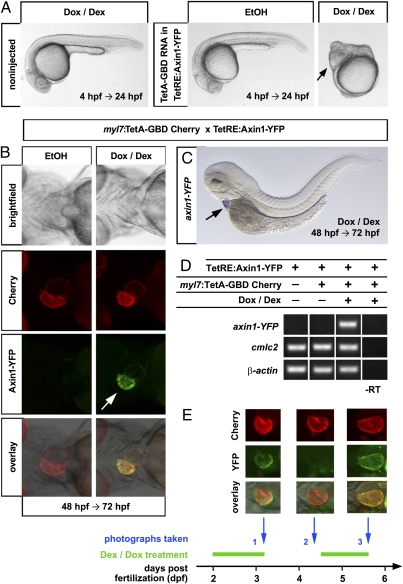Fig. 2.
Tissue-specific, reversible gene expression using the dually inducible TetA-GBD/TetRE-tight system in embryonic and adult zebrafish. (A) Severe Wnt/β-catenin loss-of-function phenotypes as evidenced by posterior truncations and expanded eyes (arrow) in TetRE:Axin1-YFP embryos injected with 100 ng/μl TetA-GBD RNA and treated with Dox/Dex from 4 h postfertilization (hpf) until 24 hpf. Note that embryos treated with EtOH vehicle and noninjected embryos treated with Dox/Dex develop normally. n = 30 noninj, 7 EtOH, 9 Dox/Dex. (B) Induction of Axin1-YFP expression in ventricle (arrow) in myl7:TetA-GBD Cherry; TetRE:Axin1-YFP double transgenic embryos treated with Dox/Dex for 24 h from 48 hpf. n = 15 EtOH, 18 Dox/Dex. (C) Heart-specific induction of Axin1-YFP RNA (arrow) after Dox/Dex treatment. n = 15. (D) Semiquantitative PCR detects axin1-YFP expression only in myl7:TetA-GBD Cherry; TetRE:Axin1-YFP double transgenic embryos treated with Dox/Dex (lane 3), but not in EtOH treated embryos (lane 2) or embryos only containing the TetRE:Axin1-YFP transgene (lane 1). myl7 and β-actin are shown as loading controls. (E) Fast reversibility and reinducibility of Axin1-YFP induction. Fluorescent images of the heart of one individual myl7:TetA-GBD; TetRE:Axin1-YFP double transgenic embryo is shown that was treated with Dox/Dex and photographed at the times indicated. Note that YFP signal is not detectable 24 h after drug withdrawal (Middle, column 2) and reexpressed after additional 24 h of drug treatment (Middle, column 3). n = 5.

